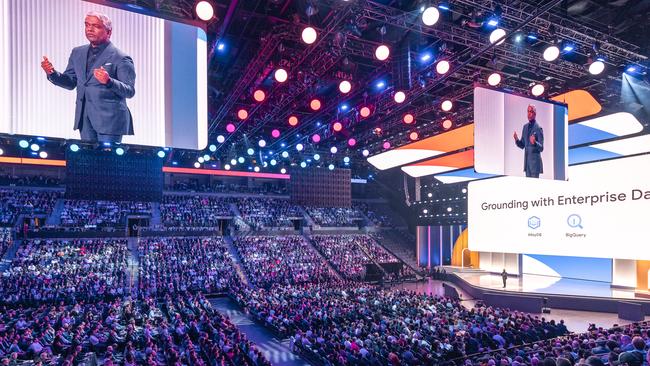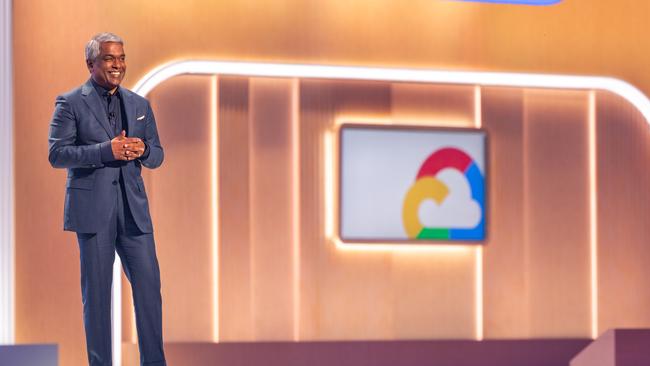What’s new in Google’s AI big reveal as it takes on Amazon, Microsoft
After a troubled start, Google is moving swiftly on catching up on rivals Microsoft and Amazon in the AI arms race.

Google has unveiled a raft of new updates to its Gemini artificial intelligence model, declaring its corporate customers can safely use the technology after a troubled start that left it trailing rivals Amazon and Microsoft.
The Alphabet-owned company is moving to court big enterprise at its annual cloud computing conference in Las Vegas, showcasing how its most powerful AI model can be used to strengthen cybersecurity, edit videos – including creating voice overs – as well as slash medical diagnosis turnaround times and analyse company earnings reports.
It is also making more of its own semiconductors – unveiling a new chip called Axion – which it says can deliver up to 50 per cent better performance and up to 60 per cent improved energy efficiency, as part of its efforts to rein in rising AI costs.
Thomas Kurian, chief executive of Google Cloud, highlighted partnerships with big name corporate clients, including Mercedes-Benz, Woolworths, McDonald’s, Goldman Sachs and Canva in an effort to add further credibility to the company’s generative AI technology. ANZ Bank and Macquarie are also Google Cloud customers.
“We have introduced new, state-of-the-art models — including our Gemini models — and brought them to developers and enterprises. And the industry is taking notice — we have been recognised as a Leader in 20 of the top industry analyst evaluations,” Mr Kurian said.
Alphabet reported 26 per cent growth in its cloud unit in latest quarterly earnings in January, thanks largely to AI.
Overcoming setbacks
Google’s generative AI technology initially had a series of setbacks. Its first effort, Bard failed to take off like ChatGPT, and also attracted criticism last year when it backed the Indigenous Voice to parliament as a “positive step”, praised Anthony Albanese as a “man of the people”, and labelled Peter Dutton and Scott Morrison as “controversial”.
In February, Google suspended Gemini’s image generation feature after users on social media revealed it was creating inaccurate historical depictions – such as replacing white people with people from other ethnic groups.
Google and Alphabet chief executive Sundar Pichai said images generated by the AI model were “completely unacceptable”, while co-founder Sergey Brin said the tech giant “definitely messed up”. It has since been working around the clock to fix its biases.
The image generation issues affected the consumer version of Gemini rather than the enterprise product, and the suspension did not apply to commercial users.
“The issue was not with the base model at all. It was in a specific application that was consumer facing,” Mr Kurian said.
“Secondly, we had zero reports of issues from enterprise customers of that problem. Third, we have got controls in the platform. We call them safety and responsibility controls in the platform that allows you to choose exactly how you want to set it.”
Giving companies greater control over AI models
For example, Mr Kurian said if auction house was describing artwork from the renaissance, there may be nudes and it would require an AI model to understand that nuance.
“On the other hand, if you’re building something for children, like a kid’s toy or education thing for kids, you don’t want to put those kinds of images in front.
“So we put 19 types of controls in the hands of individual companies and they can set it exactly the way they want. So that control I think gives them confidence that it’s reflecting not our disposition as the provider of the model, but their controls that they want to put which is reflective of the brand, reflective of the customer or user demographic, reflected even of the country in which they operate.”
Ms Kurian said companies would be able to also “ground” AI results after Google integrated the model with its search engine, which would help combat what is known as “hallucinations” – a key hurdle for businesses embracing AI.
“It is to address this concern that people have when a model hallucinates or give me an answer, what can I compare with to see if this answer is right or wrong? And we said, ‘well, there the internet, it has a lot of information, and Google search is the most trusted source of that.
“So every step whether it’s safety, responsibility, security, privacy quality, we’re doing work to integrate capability that helps people.”
Google Cloud reported a revenue run rate of $US36bn in the fourth quarter, which Mr Pichai said was five times its run rate from five years ago.
New AI-powered apps
Google Cloud launched a new app ‘Google Vids’ on Wednesday morning (Australian time), which allowed people to create professional looking videos via basic verbal prompts. Users can also record a voice over or use an AI generated one in a range of styles such as “Australian excited” or “British calm”.

Most of the updates are similar to Microsoft’s AI co-pilot, such as incorporating Gemini into Google Workspaces, which includes its Gmail, Docs and Sheets products. Like Copilot, users can ask for summaries of their email inbox or generate presentations based on various documents.
Google has about a 7.5 per cent share of the global cloud computing market, versus Microsoft and Amazon’s combined 62 per cent, according to Gartner.
Boosting efficiency for Goldman Sachs and others
But it has been steadily attracting big name corporate customers, including Goldman Sachs. The investment bank’s chief executive David Solomon said it has been using Google’s AI products to summarise public filings and interpret information like earnings reports.
“We want to be thoughtful in how we approach and harness this technology, both in the mechanism to drive efficiency and as an enabler of disruption and differentiation for our clients,” Mr Solomon said.
“We’re already seeing signs of promise in a few areas of experimentation and we’re very optimistic about that. There’s evidence to generative AI tools for assisted coding can boost developer efficiency and productivity by as much as 40 per cent.
“We’re exploring different ways to use AI, whether it’s to summarise public filings, extract sentiment and signals from corporate statements, or to gather and interpret information, like earnings reports. We have a world class team of engineers working on this and we’ve already learned a lot.”
Global healthcare giant Bayer has also partnered with Google Cloud to deploy AI to assist radiologists in medical diagnosis. ASX-listed pathology group Sonic has adopted a similar strategy after it acquired a 20 per cent stake in AI start-up Harrison.ai during a $129m Series B funding round in 2021.
Effectively, AI is designed to give pathologists and radiologists a ‘second set of eyes’.
“Radiologists and other clinicians face burnout due to the sheer volume of work they face every day,” Mr Kurian said.
“Gen AI can help tackle repetitive tasks and provide insights into massive data sets, saving valuable time and helping to positively impact patient outcomes.”
Human-like voice to text conversations
Google showcased how its AI model can create “agents”, which can provide fluent human-like conversation with customers to help them find a product while shopping online. Agents can also assist enterprise clients by helping answer employee queries, write code or design creative content.
Australians were offered a glimpse of Google’s AI conversational abilities last year when it partnered with Telstra to allow children to call Santa on pay phones. Its text-to-speech custom voice model captured Santa’s speaking tone and timbre, allowing children to have a natural conversation with him.
Combating cyber attackers
Mr Kurian also revealed how AI agents were helping combat cyber attacks.
“The number and sophistication of cybersecurity attacks continues to increase, and gen AI has the potential to tip the balance in favour of defenders, with security agents providing help across every stage of the security life cycle: prevention, detection and response,” Mr Kurian said.
“Leading global brands are already seeing the benefits in their security programs. At Pfizer, data sources that used to take days to aggregate can now be analysed in seconds. 3M is using Gemini in Security Operations to help their team cut through security noise, while engineers in Fiserv’s Security Operations Center are able to create detections and playbooks with significantly less effort, and analysts get answers more quickly.”
The author travelled to Las Vegas as a guest of Google Cloud.




To join the conversation, please log in. Don't have an account? Register
Join the conversation, you are commenting as Logout